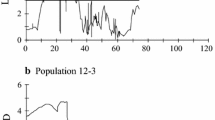Summary
Anthocyanic purple pigment expresses itself in the sorghum plant in various places and at various times. This occurrence could be grouped into specific chains of manifestation. The anther is rarely coloured purple. When it is so coloured, it is one among the following ten places in its chain: plumule, nodal band, axil, auricular junction, leaf-sheath margin, pulvinus of the panicle branches, pedicelled spikelets, glume tips, exposed roots and pericarp of the grain at milky stage. The expression of this purple in freshly emerging anthers is noted in some races of cultivated sorghum, East African and Nigerian in origin, belonging to the groupsS. caudatum, S. coriaceum, S. nigricans, S. elegans, S. Roxburghii, andS. conspicuum. Purple in the anthers occurs in the wild sorghumsS. halepense of the Eu-Sorghum group, andS. versicolor, S. dimidiatum andS. purpureo- sericeum of the Para-Sorghum group. A gene designated P an is responsible for this expression of purple in the anther. In its absence (P an ) the anther is of the ordinary yellow colour. P an is a simple dominant to P an in crosses between African races. Factor P an behaves in inheritance independently of one of the B factors determining the brown colour of the grain of the Q factor conditioning the colour of the leaf-sheath and of the factor responsible for the production of brown colour in the nucellar layer of the grain. The occurrence of this dominant gene along with other similar dominant pigment genes6,7 in African races and their disappearance in the Indian and other Asiatic races throws light on the origin and evolution of cultivated sorghums.
Similar content being viewed by others
literature cited
Rangaswami Ayyangar, G. N.,et al. Ind. Jour. Agric, Sci., 1933,3, Part IV, 589–594.
— —, 594–604.
Rangaswami Ayyangar, G. N.Madras Agric. Jour., 1934,22, No. 1, 1–11.
—,et al. Indian Jour. Agric. Sci., 1936,6, Part II, 481–83.
—Proc. Ind. Acad. Sci., 1935,2, No. 6, 508–22.
—Curr. Sci., 1937,5, No. 11, 590.
— —, 1938,6, No. 12, 612–13.
—Ind. Jour. Agric. Sci., 1933,3, Part IV, 606.
Rangaswami Ayyangar, G. N.Madras Agric. Dept. Sub. Off. (Millets Specialist)Rep., 1925–26, 264.
—Jour. Madras Agric. Stu. Union, 1927,15, No. 1, 4.
Author information
Authors and Affiliations
Rights and permissions
About this article
Cite this article
Rangaswami Ayyangar, G.N., Rao, V.P. & Reddy, T.V. The occurrence and inheritance of purple anthers in sorghum. Proc. Indian Acad. Sci. 8, 317–323 (1938). https://doi.org/10.1007/BF03048221
Received:
Issue Date:
DOI: https://doi.org/10.1007/BF03048221




